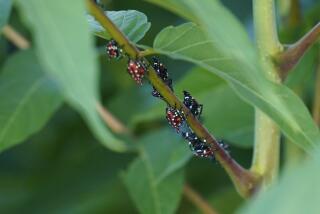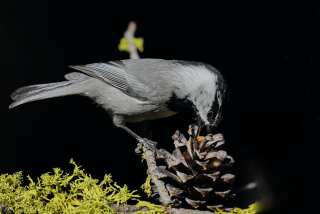After 17 years, cicadas prepare assault on Midwest
- Share via
CHICAGO — Normally, this would be the beginning of the busy season at Jim Nadeau’s ice-sculpting company.
But when the phone rings, Nadeau tells confused Chicago-area brides and party planners that they might want to postpone their events. “The cicadas are coming!” he tells them.
“You don’t know how disgustingly bad they can be,” said Nadeau, 53, who has been carving ice figures for 27 years in Forest Park, Ill.
“The last time they were here, I watched one of my simple swans at a wedding reception get covered with these black, crawling bugs -- and the swan was sitting in the middle of the food table,” Nadeau said. “The swan was 4 feet tall and weighed 300 pounds.”
All across the Midwest, people are bracing for a noisy, messy month. After spending the customary 17 years underground, cicadas classified as the Brood XIII strain have begun to emerge.
In the coming days, the cicadas -- with their orange eyes and inch-long bodies -- are expected to swarm sections of Illinois, Indiana, Iowa, Michigan and Wisconsin for their breeding season.
After the bugs emerge from the soil and shed their exoskeletons, the males emit a sound to attract females. The tone, a cross between a whirring blender and a motorcycle engine, can reach 90-plus decibels.
The females, in turn, climb onto tree branches and tender trunks, slice into the bark and lay their fertilized eggs. Though the egg-laying process can damage branches, they’re more annoying than threatening to people. Scientists predict a massive swarm of them this year -- as many as 1.5 million bugs per acre, particularly in wooded areas where the soil has remained relatively undisturbed over the years. Adult cicadas live above ground for two to six weeks.
Tom Tiddens, supervisor of plant healthcare for the Chicago Botanic Garden, recalled the last time the cicadas arrived here in such force: It was 1990, and he had recently started working at the public botanic gardens in the northern Chicago suburb of Glencoe, Ill.
“I’d be out in the trees working, and have someone five feet from me. We couldn’t talk to one another because you couldn’t hear them,” Tiddens said.
He expects this year’s crop to be just as large.
“The wildlife is going crazy. You see squirrels and raccoons and skunks digging in the dirt, feasting on the cicadas that haven’t come out yet,” Tiddens said.
“It’s like Thanksgiving in May for them.”
Many residents are equally fascinated with the impending invasion, which has sparked a strange mania in the Windy City.
Some Midwesterners are planning bug-themed dinners and have flocked to culinary websites to swap recipes for cicada cookies and discuss which wine would be best paired with “el chirper” tacos.
Chicago’s Field Museum is opening an exhibit on cicadas, and the Morton Arboretum will host a series of lectures. The Chicago Tribune posted instructions on its website on how to make an origami cicada -- as well as an online game called “Swat the Cicada,” where players can squash the bugs with a virtual fly swatter.
When Welz Kauffman moved from California to join the Ravinia Festival in 2000 as its president and CEO, the staff warned him about the coming of the cicadas.
Kauffman asked the board of directors if he could take a sabbatical this summer, to avoid the bugs altogether. They said no.
So Kauffman gritted his teeth and revised the festival’s schedule, by shifting the Chicago Symphony Orchestra to later in the season and moving other concerts to indoor venues.
Some shows, though, he left alone.
“The Doobie Brothers? They’re going to be able to drown out the bugs,” Kauffman said. “The Mormon Tabernacle Choir? They told me not to worry: They’re Mormon. They know how to handle locusts.”
*
More to Read
Sign up for Essential California
The most important California stories and recommendations in your inbox every morning.
You may occasionally receive promotional content from the Los Angeles Times.













